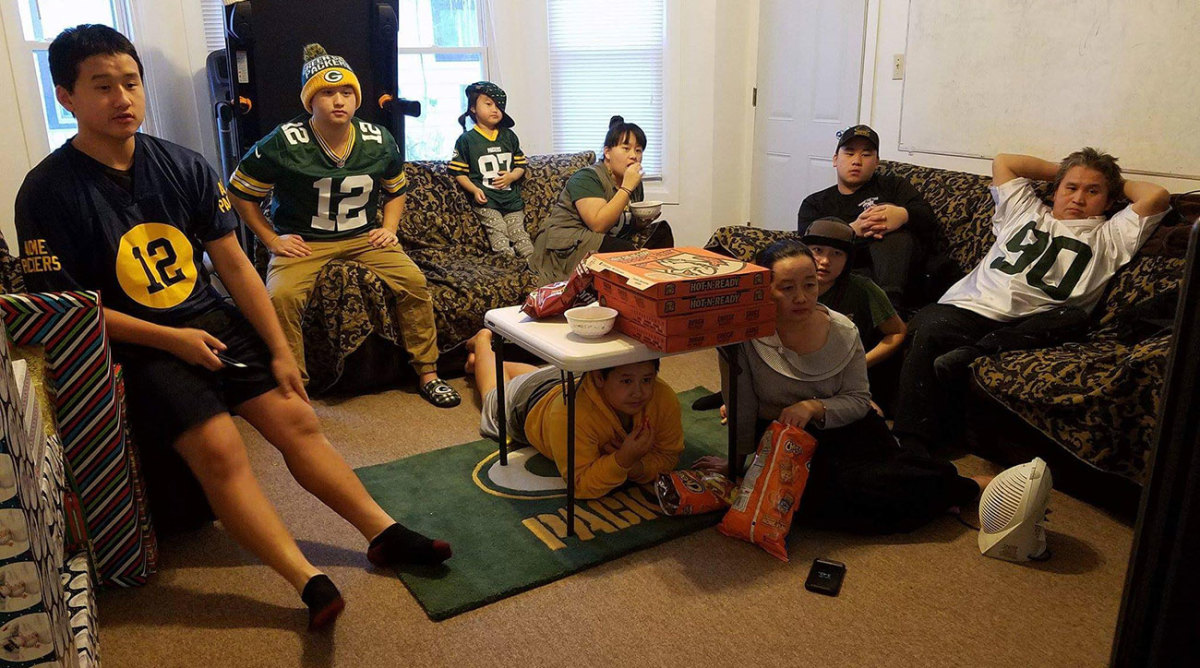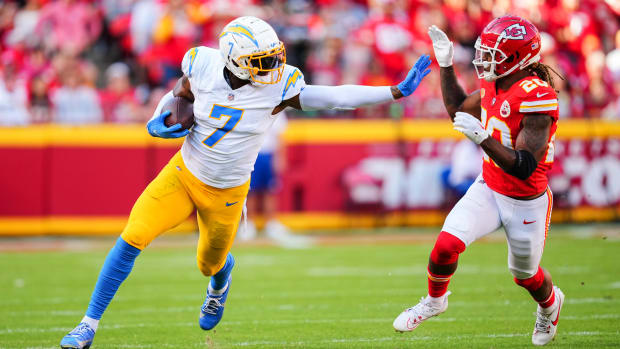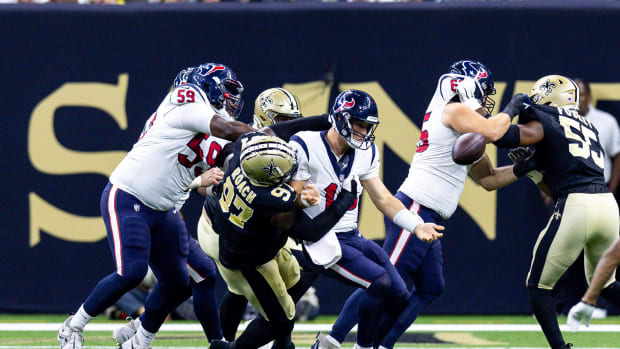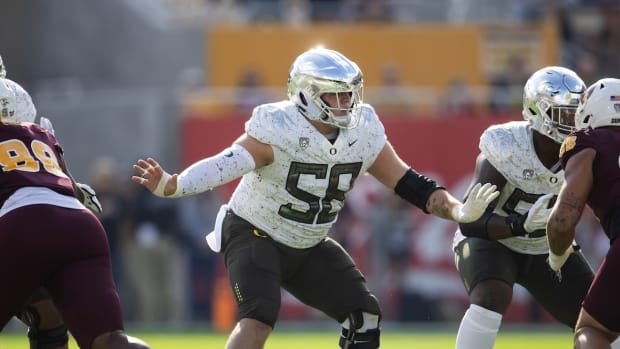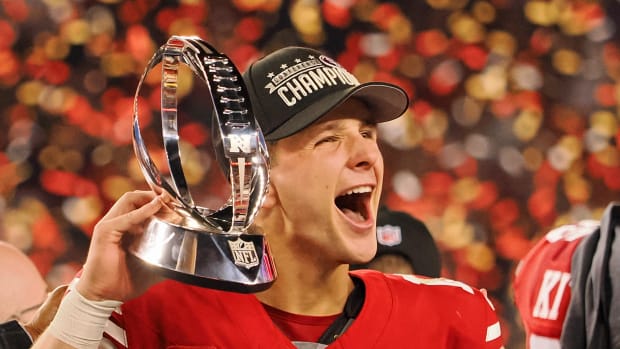From Laos to Wisconsin, and into the Heart of Packers Country
GREEN BAY, Wis. — Chong Xiong, 16, grew up watching the Packers on television following Sunday morning services at his church on 3rd Street, where men and women consumed with the Holy Spirit find themselves kneeling and weeping at the altar during the pastor’s most passionate sermons. Xiong’s family is a part of the growing Christian subset of Green Bay’s most unexpected minority—the Hmong, a group of mostly refugees displaced from Southeast Asia by the Vietnam War and its aftermath. When Xiong entered high school, he got his first opportunity to attend a Packers game, not as a paying fan but as a volunteer, sweeping up discarded beer cans and bottles at the gates and throughout the concourses.
“It was pretty great,” he says of the volunteer labor. “Loud crowd.” Xiong and his friends would wait for the unseen crowd to surge in cheers, then try to find a nearby overhead television to see the highlight: “They have TVs everywhere, so sometimes you can see them score.”
A sophomore at Green Bay West High, Xiong was a member of the Hmong New Life Church volunteer group, one of a handful of Hmong organizations that have volunteered to do the dirty work for the Packers over the last five years in exchange for donations toward the groups. A group of 15 in-game volunteers from New Life Church earn a total of about $1,100 per game (depending on the weather), money that often goes to church renovations or mission trips.
LAMBEAU 360°: THE PACKERS PREGAME SCENE
The Hmong are among the most isolated minority groups in this town of roughly 104,000; whether they practice shamanism or their adopted evangelical Christianity, they do it almost exclusively among Hmong, and cluster in Hmong-centric friend groups at the public schools. But there is one aspect of mainstream Green Bay they’re mainlining: football.
“I believe soccer was once more popular among Hmong,” says Anthoni Her, 45, part-time pastor at the Green Bay New Salvation Church of God, “but right now I believe football is more popular.”
Her, who has three children in college and works as a technician at the local Proctor and Gamble production plant, is a regular attendee of local Hmong festivals on summer holidays at the Brown County Fairgrounds. Soccer tournaments once held sway at these functions, but in the last five years, as Hmong participation in the cleanup efforts at Lambeau has swelled to over 100 volunteers from various community groups on any given home-game weekend, flag football has overtaken soccer in popularity.
“Those are the really big games, and you get a big crowd now,” Her says, “and soccer has died down.”
Her’s family emigrated from Laos in 1980 as part of U.S. efforts to grant political asylum to Hmong people, many of whom were recruited by or supported the U.S. during its efforts to quell the rise of communism in Vietnam and Laos. Beginning in Wausau, Wis., churches and cities invited the wave of refugees. The 2010 U.S. counted just under 50,000 Hmong in Wisconsin, putting the state behind only California and Minnesota in Hmong population. At least double that number are estimated to have died in the genocidal backlash of the Vietnam War. It’s an ugly chapter of history often lost on Americans, including those in Green Bay.
“A lot of people don’t understand our history and heritage so they take us for Chinese or whatever,” Her says. “But we helped the Americans, and because we didn’t win and we lost our country, there was an agreement made to allow us to come here. A lot of people have stories of crossing the Mekong River with infants children in their arms, fleeing the Vietnamese.”

The post-pregame scene at Lambeau Field. Hmong residents volunteer at the stadium in exchange for donations to community groups.
John DePetro/The MMQB
Most Hmong in Green Bay under 30 years old are first-generation Americans straddling the gray line between assimilation and maintaining and preserving Hmong tradition and culture. Adam Vang, who spent some of his Sunday sweeping up trash at the Oneida gate, is a sophomore at Green Bay Southwest High who plays in the church youth band. Hmong-language songs are popular among the 100 or so New Life church-goers, but the kids enjoy adapting modern worship songs like “Ever Be” and “Broken Vessels” to their rock ensemble featuring an acoustic guitar, a base guitar and a piano.
“We always ask the church to dance,” Vang says. “I think they get more out of the Hmong songs because they have more in common with that language and a better understanding.”
Hmong youth inclined to play football for Green Bay-area high schools can run into difficulty selling their parents on participating in the pastime, as opposed to admiring it from afar. "I know a lot of parents don’t encourage their kids to play football,” says Zee Lo, whose son Troy plays running back for Ashwaubenon High. “They want their children to be doctors and lawyers. They don’t want their kids to get injured, and two there’s no career in it.”
And when Hmong do get gravely injured, or sick, many families who practice animism lean on family shamans, who are believed to mediate between the world visible to the naked eye and the spirit world. For minor injuries, families often rely on herbal remedies. “Many Hmong won’t go to the doctor for a sprained ankle,” Lo says.
Flag football, however, has broken through in a big way. Hmong communities from Minneapolis to Appleton host under-18, under-21 and adult tournaments at Hmong festivals on Memorial Day, Independence Day and Labor Day. Ma Xiong, Chong’s older brother, plays on a team called simply “Run,” whose ranks have swelled up to 30 members. “The last few years it’s been growing pretty fast,” Ma says. Anybody can start a team, but because it’s a Hmong tournament, you have to have Hmong on the team. I think we've embraced it because when you come to another country you need something to relate to. It's a great thing to be able to share with people and connect to.”
In the winter when there are no festivals or tournaments, the Xiongs get their football fix on Sundays watching Aaron Rodgers and snacking on pizza and chips.
“Like anybody else,” Ma says, “We eat chips, talk, laugh, just have a good time watching the Packers win.”
• Tell us what you thought of Green Bay Week at The MMQB by email at talkback@themmqb.com.
































